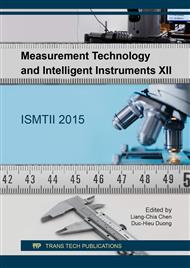p.237
p.243
p.249
p.257
p.263
p.271
p.277
p.283
p.289
Standardization of Current-Voltage Test Method for DSSC Products
Abstract:
The major differences between dye sensitized solar cell (DSSC) and p-n junction solar cells are spectrum absorption range, photoelectric conversion response time and standard test condition (STC). The operation principle of DSSC is using layers of organic molecules subject to lighting after excitation electronic then pass to the inorganic/organic layer of the wide energy gap nanolayer and voltage. Therefore, characterizations of DSSC are important in order to clarify how to determine its performance accurately. Such measurement requires considering the different level lighting on each very slow temporal response (hysteresis and transient) in its current-voltage (I-V) curves, which are dependent on the voltage sweep direction, even when the sweep time is the order of seconds. This paper presents a new test method for determining I-V performance of DSSC, which differs with IEC 60904-1 addressed on single and multi-junction samples. Results were applied to SEMI Doc. 5597 and released as SEMI PV57 by voting in 2014. Consequently, emerging photovoltaic device makers and buyers, or any other party interested, can thus have a common testing standard to refer to when desired.
Info:
Periodical:
Pages:
263-268
Citation:
Online since:
September 2017
Authors:
Price:
Сopyright:
© 2017 Trans Tech Publications Ltd. All Rights Reserved
Share:
Citation:


